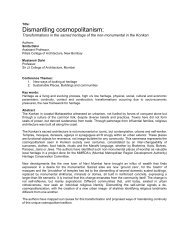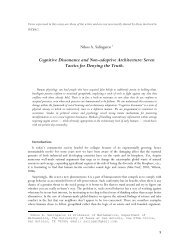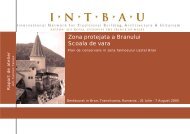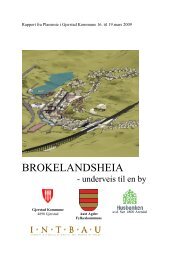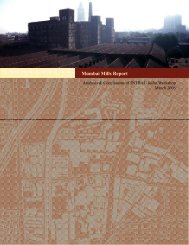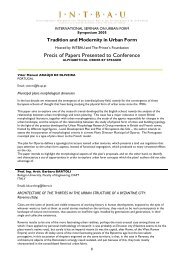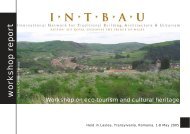Thematic Area 1: New ways of looking at heritage Sub ... - Intbau
Thematic Area 1: New ways of looking at heritage Sub ... - Intbau
Thematic Area 1: New ways of looking at heritage Sub ... - Intbau
Create successful ePaper yourself
Turn your PDF publications into a flip-book with our unique Google optimized e-Paper software.
a part <strong>of</strong> the Universe giving expression to the ideals <strong>of</strong> its own eternal beauty andunchanging law [1].Therefore, for any architecture to be perfect, it had to s<strong>at</strong>isfy parameters such as astrologicalobserv<strong>at</strong>ions, principles <strong>of</strong> eternal beauty, laws <strong>of</strong> n<strong>at</strong>ure etc. as defined in the texts <strong>of</strong> th<strong>at</strong>age. This could have been done only with detailed project planning and execution. Theexistence <strong>of</strong> ancient monuments can be taken as an indic<strong>at</strong>ion <strong>of</strong> presence <strong>of</strong>multidisciplinary and multil<strong>at</strong>eral knowledge [2] base <strong>of</strong> design and managerial skills. Thearchitect (sthap<strong>at</strong>i) was the central figure in the entire scenario and with his team <strong>of</strong> assistantsthe work was executed. For any architectural project, perfection in all aspects was the mostsought after goal.Documenting and Understanding Ancient Indian ArchitectureOne <strong>of</strong> the early pioneers <strong>of</strong> Indology, and the founder <strong>of</strong> the Royal Asi<strong>at</strong>ic Society <strong>of</strong> Bengalwas Sir William Jones (1746-94) [3]. Archaeological and historical pursuits in India startedwith his efforts, who put together a group <strong>of</strong> antiquarians to form the Asi<strong>at</strong>ick Society on 15 thJanuary 1784 in Calcutta (now Kolk<strong>at</strong>a). The public<strong>at</strong>ion <strong>of</strong> a periodical journal named,Asi<strong>at</strong>ic Researches was started in 1788, in the researches, surveys carried out by the societywere published to make the public aware <strong>of</strong> the antiquarian wealth <strong>of</strong> India [4].In the same decade, William Hodges, the first <strong>of</strong> the British pr<strong>of</strong>essional landscape artists tovisit India, spent over three years in the country from 1780 to 1783 and painted amongstother subjects, the architectural <strong>heritage</strong>. [5] He published his reflections on the country'sarchitecture partly in the notes accompanying his series <strong>of</strong> aqu<strong>at</strong>ints, 'Select Views in India'(1785-88) and then more coherently in his 'Dissert<strong>at</strong>ion on the Prototypes <strong>of</strong> Architecture:Hindu, Moorish and Gothic <strong>of</strong> 1787'. This m<strong>at</strong>erial was repe<strong>at</strong>ed and amplified in his volume<strong>of</strong> memoirs, 'Travels in India' <strong>of</strong> 1793. In all his works, Hodges clearly perceived th<strong>at</strong> Indianarchitecture had its own conventions, which were quite unknown to Europe. Wh<strong>at</strong> his worklacked entirely was any reference to the Shilpa Shastras, the traditional and time-honouredtexts in which the local conventions rel<strong>at</strong>ing to architecture were clearly explained [6]. TheArchaeological Survey <strong>of</strong> India has been involved in architectural surveys <strong>of</strong> monuments tilld<strong>at</strong>e and has a very rich collection <strong>of</strong> architectural document<strong>at</strong>ion [7].The research in this area can be classified into two c<strong>at</strong>egories, namely, Field work andTheoretical work. The above works can be classified as field work. In the theoretical researchfront, the first person who <strong>at</strong>tempted to understand ancient Indian Architecture was Ram Raz[8] .Since 1812, Ram Raz collected ancient architectural tre<strong>at</strong>ises in Sanskrit and toiled todecipher their mysteries. The result was 'The Essay on the Architecture <strong>of</strong> the Hindus',posthumously published in London in 1834. Ram Raz's book was a p<strong>at</strong>h-breaking work in thefield <strong>of</strong> Hindu architecture. He was the first Indian scholar to study the principles <strong>of</strong> Hinduarchitecture as reflected in the ancient Hindu architectural tre<strong>at</strong>ises. His work was also quotedby Owen Jones [9] in chapter 13 ‘Hindoo Ornament’ <strong>of</strong> his book ‘Grammar <strong>of</strong> Ornament’.Another researcher in this area, Dr. P.K. Acharya [10], also selected the Manasara fortransl<strong>at</strong>ion and graphical transcription. His work is available in a number <strong>of</strong> volumes firstpublished from 1934 to 1946. The tre<strong>at</strong>ise ‘Samrangana Sutradhara’ was selected by Dr. D.N. Shukla [11] for his research on Indian architecture and published in 1960. TheMayam<strong>at</strong>am, another architectural text was transl<strong>at</strong>ed by Dr. Bruno Dagens which was firstpublished in English in 1984 by I'Institut Francais d'Indologie, Pondicherry and Bhar<strong>at</strong>iaInstitute, <strong>New</strong> Delhi. The same work was then published in a bilingual edition in 1994 andcontains critically edited Sanskrit text which is an improvement over the earlier edition as itcontains explan<strong>at</strong>ory footnotes, analytical table <strong>of</strong> contents and a comprehensive glossary[12].



